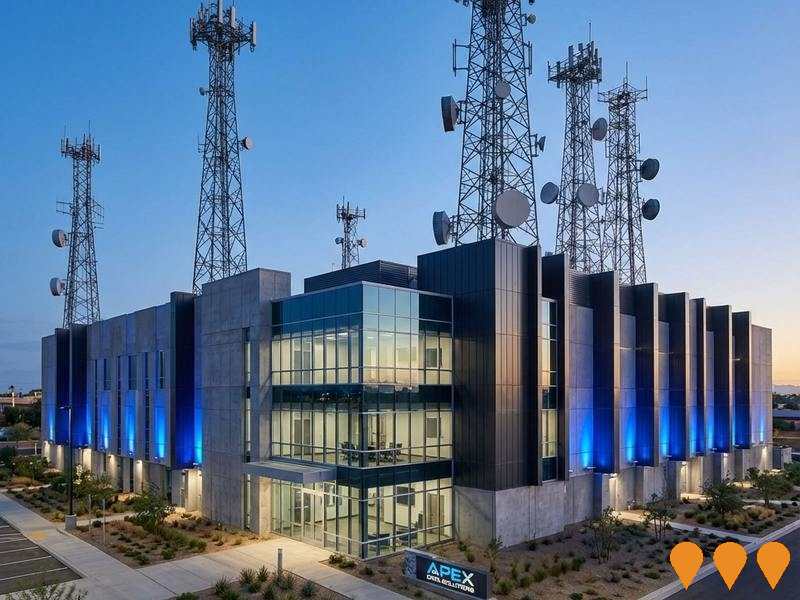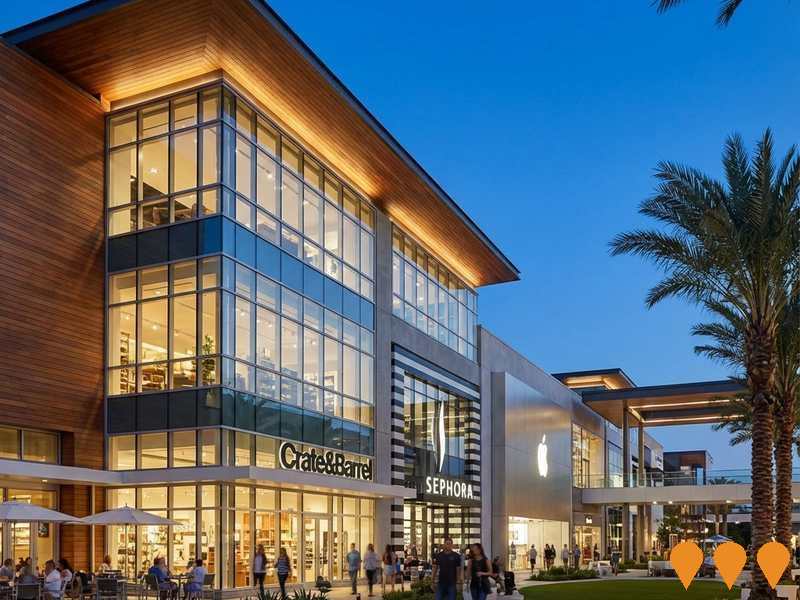Chart Color Schemes
est. as @ -- *
ABS ERP | -- people | --
2021 Census | -- people
Sales Activity
Curious about local property values? Filter the chart to assess the volume and appreciation (including resales) trends and regional comparisons, or scroll to the map below view this information at an individual property level.
Find a Recent Sale
Sales Detail
Population
Throsby lies within the top quartile of areas nationally for population growth performance according to AreaSearch analysis of recent, and medium to long-term trends
Throsby's population was around 3,575 as of August 2025, reflecting an increase of 1,170 people since the 2021 Census which reported a population of 2,405. This growth is inferred from ABS estimated resident population data for June 2024 and additional validated new addresses since the Census date. The population density was 2,415 persons per square kilometer as of August 2025, placing Throsby in the upper quartile relative to national locations assessed by AreaSearch. Throsby's growth rate of 48.6% since the 2021 Census exceeded both the state's growth rate (5.7%) and the SA4 region, indicating it was a growth leader. Interstate migration contributed approximately 83.7% of overall population gains during recent periods, with all drivers including natural growth and overseas migration being positive factors. AreaSearch adopted ABS/Geoscience Australia projections for each SA2 area released in 2024 with a base year of 2022, and ACT Government's SA2 area projections for years post-2032.
Based on the latest population numbers, Throsby is forecast to increase by 1,165 persons to reach approximately 4,740 by 2041, a total increase of 32.6% over the 17-year period.
Frequently Asked Questions - Population
Development
AreaSearch assessment of residential development activity positions Throsby among the top 25% of areas assessed nationwide
Throsby has received approximately 78 dwelling approvals per year. Between FY21 and FY25, a total of 393 homes were approved, with none yet in FY26. Each dwelling built attracted an average of 6.5 people annually over the past five financial years.
This high demand exceeds new supply, leading to price growth and increased buyer competition. The average construction value for new properties was $438,000, which is moderately higher than regional levels. There have been $45.3 million in commercial approvals this year, indicating robust local business investment. Compared to the Australian Capital Territory, Throsby has 602% more construction activity per person, reflecting strong developer confidence. All new constructions have been standalone homes, maintaining Throsby's suburban character and appealing to families seeking space.
With around 504 people per dwelling approval, Throsby exhibits a developed market. Population forecasts project an increase of 1,165 residents by 2041. At current development rates, new housing supply should comfortably meet demand, providing favorable conditions for buyers and potentially supporting growth beyond current projections.
Frequently Asked Questions - Development
Infrastructure
Throsby has emerging levels of nearby infrastructure activity, ranking in the 24thth percentile nationally
Changes to local infrastructure significantly impact an area's performance. AreaSearch has identified 19 projects that may affect this region. Notable ones include Moncrieff East Residential Estate, Harrison Town Centre Development, Throsby School, and Harrison Local Centre Expansion (Harrison 5 Precinct). The following list details those considered most relevant.
Professional plan users can use the search below to filter and access additional projects.
INFRASTRUCTURE SEARCH
 Denotes AI-based impression for illustrative purposes only, not to be taken as definitive under any circumstances. Please follow links and conduct other investigations from the project's source for actual imagery. Developers and project owners wishing us to use original imagery please Contact Us and we will do so.
Denotes AI-based impression for illustrative purposes only, not to be taken as definitive under any circumstances. Please follow links and conduct other investigations from the project's source for actual imagery. Developers and project owners wishing us to use original imagery please Contact Us and we will do so.
Frequently Asked Questions - Infrastructure
Throsby District Playing Fields
ACT Government project to deliver multi-sport district playing fields on the former Home of Football site in Throsby, serving the wider Gungahlin region. Initial scope focuses on outdoor fields that can host rugby league, rugby union, football and cricket, plus a pavilion and supporting amenities. Detailed design is underway with construction scheduled to commence in 2026.
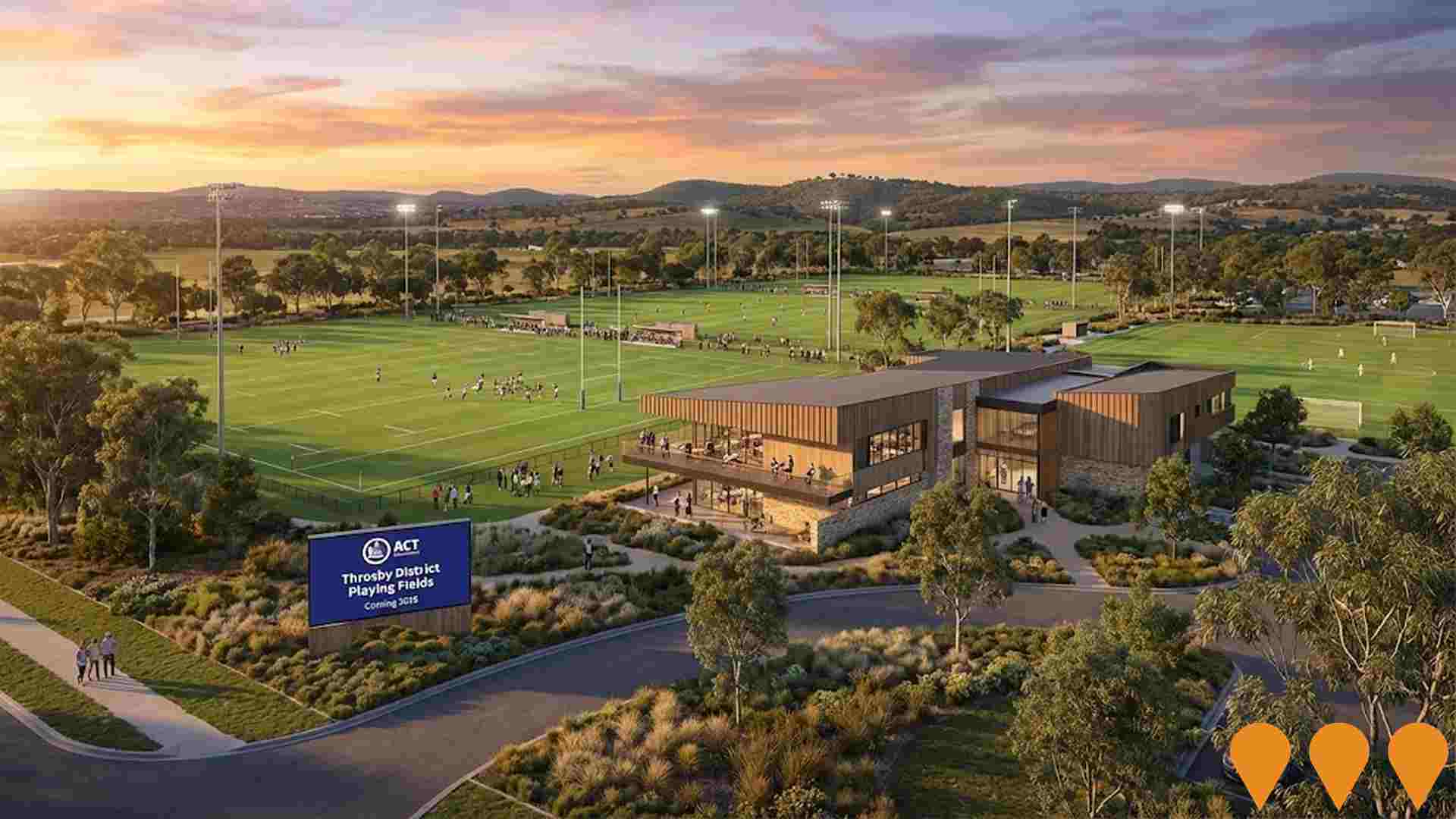
Harrison Local Centre Expansion (Harrison 5 Precinct)
Proposed mixed-use local centre expansion including ground-floor retail/commercial space, up to 150 apartments and a new community facility adjacent to the existing Harrison local shops.
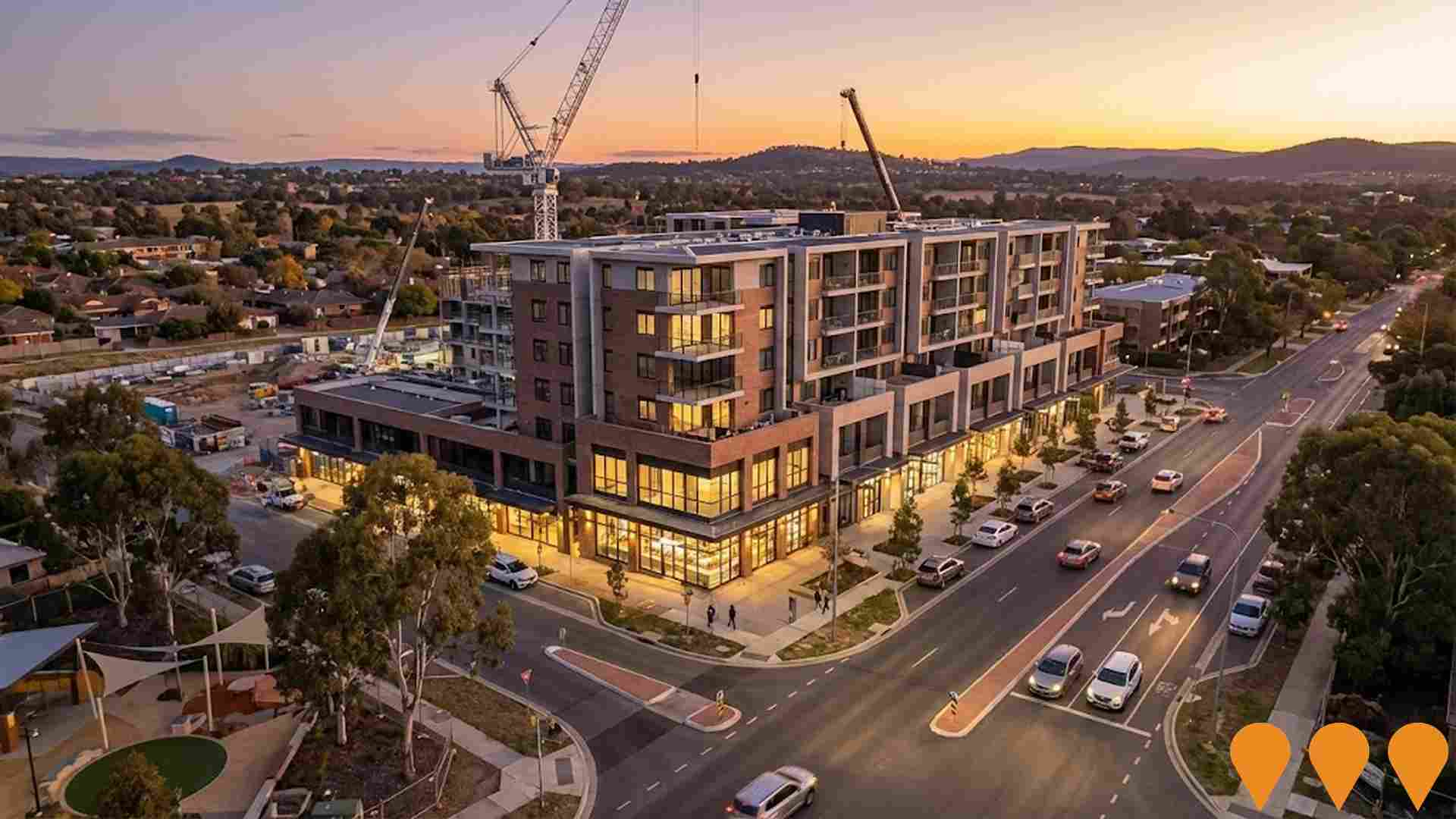
Moncrieff East Residential Estate
Large greenfield residential release delivering over 800 dwellings, new local parks, and community facilities. The Moncrieff East Estate development plan aims for approximately 1250 dwellings, public open space, and includes master planning and detailed design for a subdivision in the eastern part of Moncrieff (approximately 85ha). Civil works contracts have been awarded to Group 1 and Canberra Contractors.
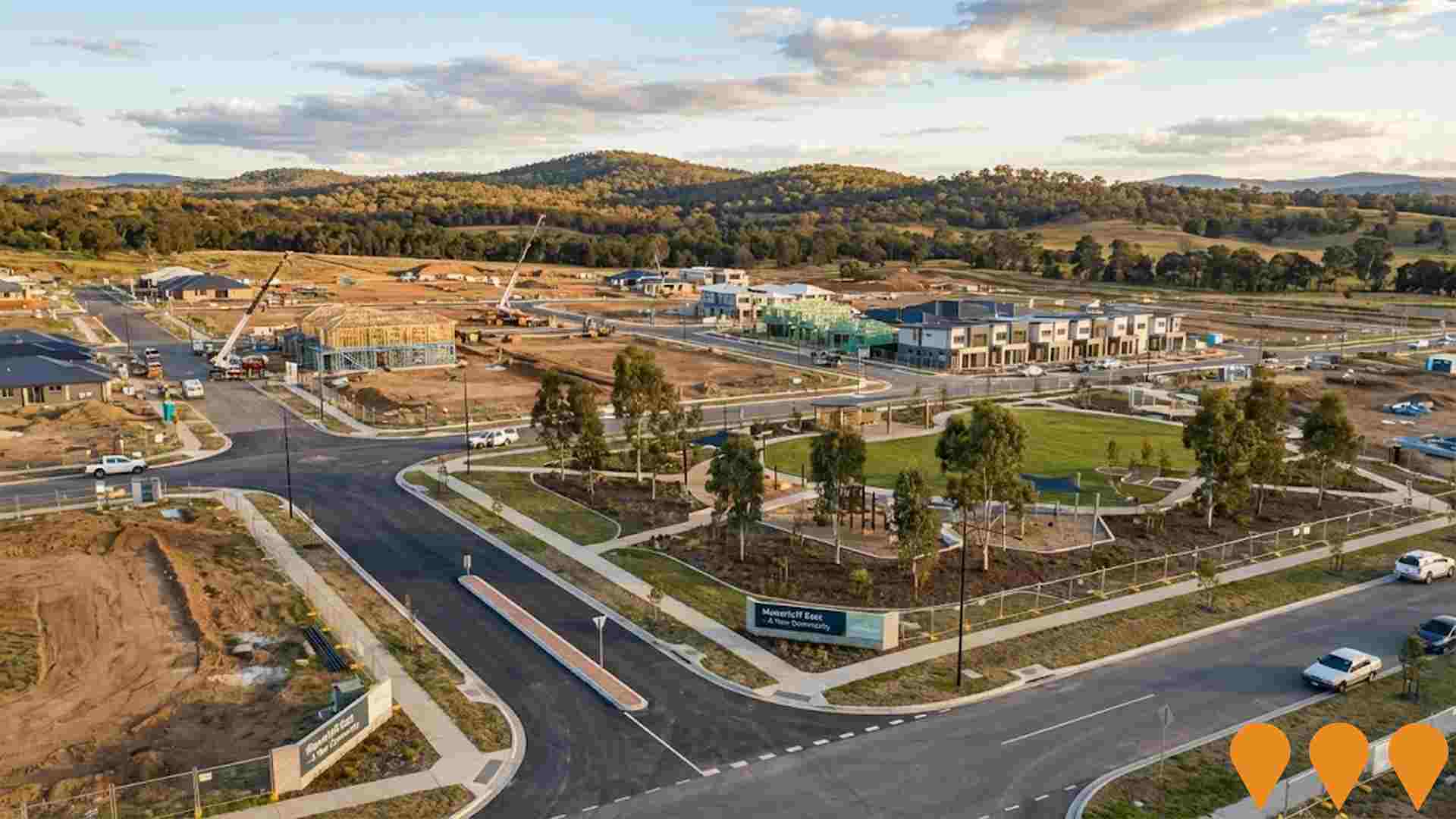
Harrison Town Centre Development
Mixed-use town centre development including retail, commercial, and residential components. Part of the broader Gungahlin district expansion plan. Features neighbourhood shops, cafes, service businesses, and community amenities to serve Harrison residents.
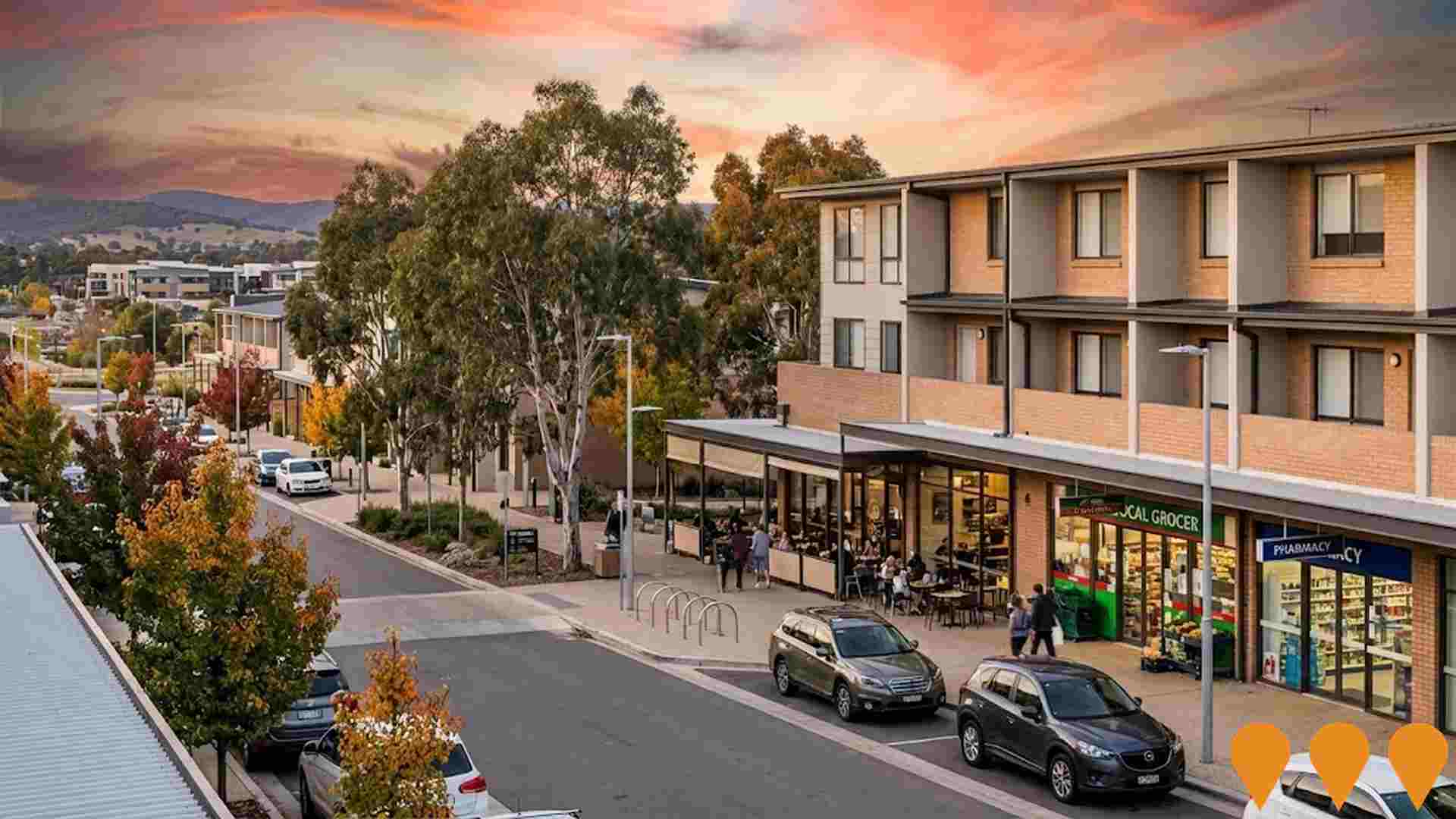
Throsby School
Throsby School is a new ACT public preschool to year 6 campus that opened for the 2022 school year. It is the ACT's 90th public school and operates as an all-electric, low-emissions facility with specialist spaces for STEAM learning, music and arts, a double gym and community rooms.

Franklin Residential Development
New residential development in Franklin offering mixed housing typologies including apartments, townhouses and detached homes. Planned community with parks, walking trails and local retail amenities.
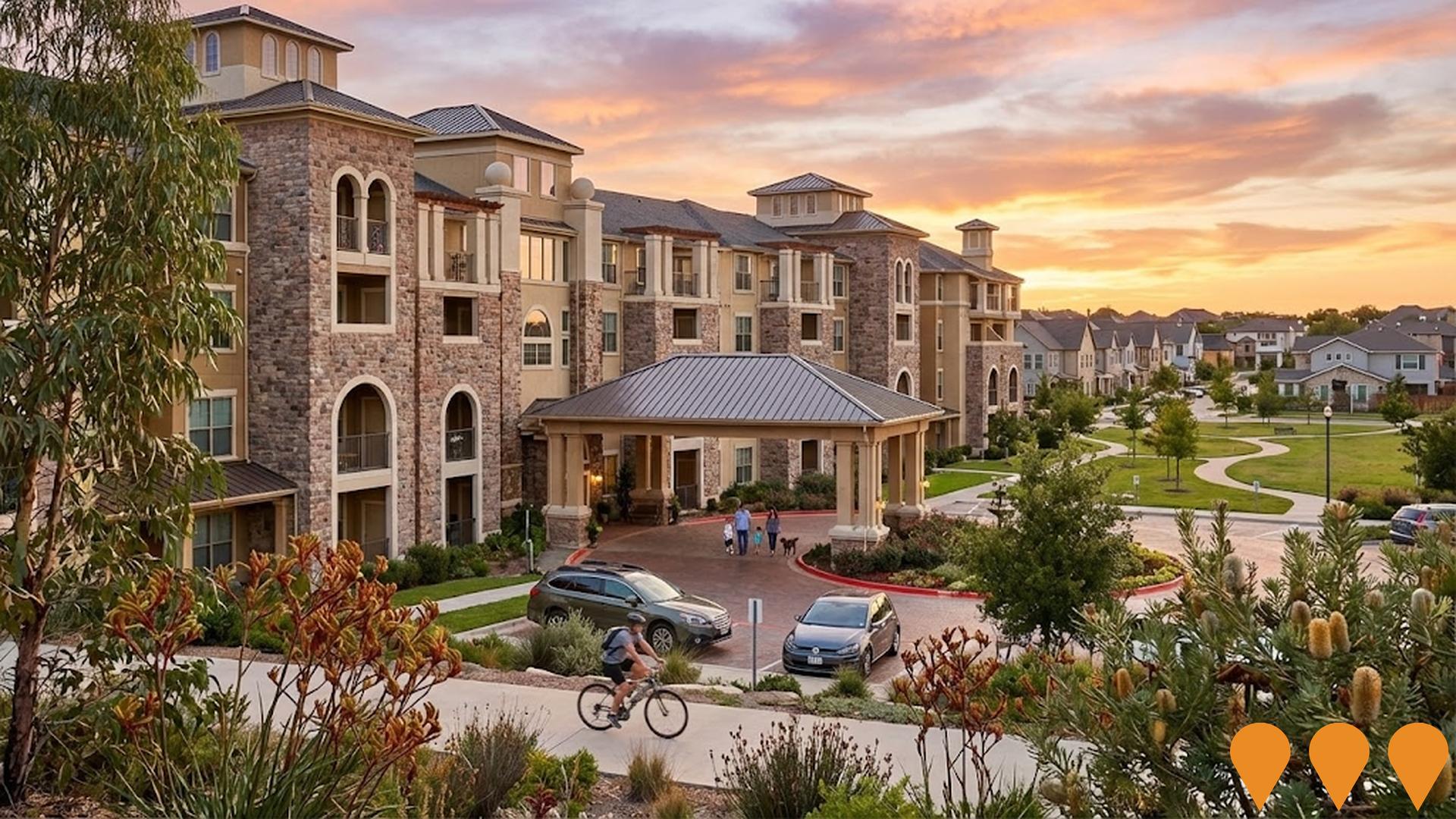
Franklin Early Childhood School Expansion
Major expansion of Franklin Early Childhood School including new preschool and primary facilities to accommodate growing population in Franklin and surrounding Gungahlin suburbs.
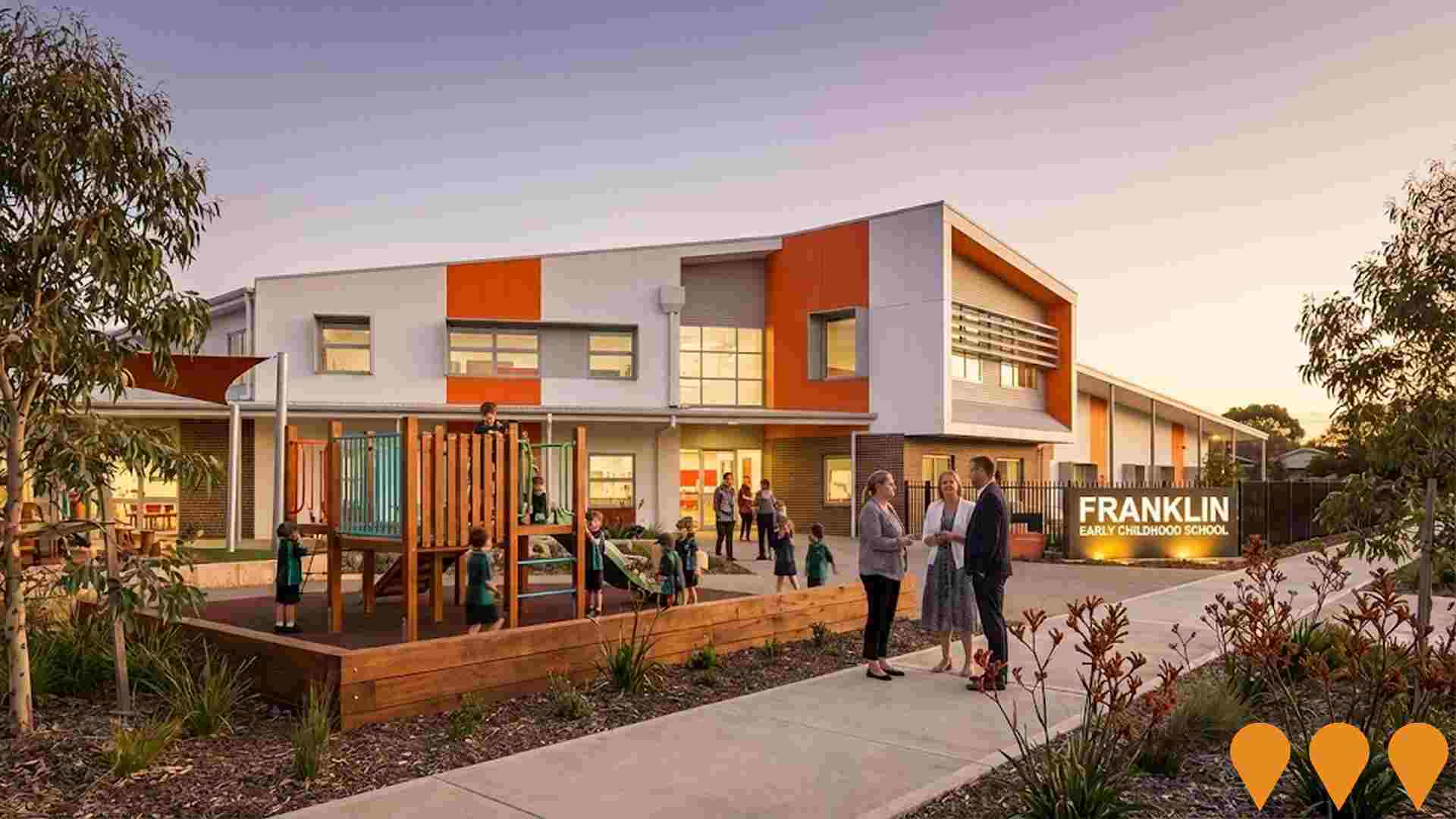
Franklin Storm Water Management
Comprehensive storm water management system including retention ponds, improved drainage infrastructure and flood mitigation measures.

Employment
Employment performance in Throsby ranks among the strongest 15% of areas evaluated nationally
Throsby has a highly educated workforce with professional services showing strong representation. The unemployment rate in Throsby is 2.0%, compared to the Australian Capital Territory's (ACT) rate of 3.4%.
Over the past year, there was an estimated employment growth of 2.5% in Throsby. As of June 2025, 1,912 residents are employed with a local unemployment rate of 1.4%, lower than the ACT's rate. Workforce participation is higher at 81.4% compared to the ACT's 69.6%. Employment in Throsby is concentrated in public administration & safety (28.9%), professional & technical services (37.5%), and health care & social assistance (20%).
The area has a particular employment specialization in professional & technical services, with an employment share of 1.3 times the regional level. However, public administration & safety has limited presence compared to the regional average. Between June 2024 and June 2025, employment levels increased by 2.5% while labour force increased by 1.6%, leading to a decrease in unemployment rate of 0.9 percentage points. By comparison, ACT recorded employment growth of 1.9%. Jobs and Skills Australia's national employment forecasts from May 2025 project national employment expansion by 6.6% over five years and 13.7% over ten years. Applying these projections to Throsby's employment mix suggests local growth of approximately 6.8%% over five years and 13.7% over ten years, although this is a simple weighting extrapolation for illustrative purposes only.
Frequently Asked Questions - Employment
Income
The economic profile demonstrates exceptional strength, placing the area among the top 10% nationally based on comprehensive AreaSearch income analysis
AreaSearch's latest postcode level ATO data for financial year 2022 shows Throsby's median income among taxpayers is $74,748. The average income is $85,530. This places Throsby among the highest in Australia, compared to the Australian Capital Territory's median of $68,678 and average of $83,634. Based on Wage Price Index growth of 13.6% since financial year 2022, current estimates for median income are approximately $84,914 as of September 2025, with the average being around $97,162 during this period. Census data indicates household, family and personal incomes in Throsby rank highly nationally, between the 95th and 98th percentiles. The earnings profile shows 31.7% of the population (1,133 individuals) fall within the $1,500 - 2,999 income range, similar to the surrounding region where this cohort represents 34.3%. A significant 54.1% earn above $3,000 weekly. High housing costs consume 16.4% of income, but strong earnings place disposable income at the 97th percentile. The area's SEIFA income ranking places it in the 10th decile.
Frequently Asked Questions - Income
Housing
Throsby is characterized by a predominantly suburban housing profile, with ownership patterns similar to the broader region
Throsby's dwelling structure, as per the latest Census, comprised 90.4% houses and 9.6% other dwellings. In comparison, the Australian Capital Territory had 66.3% houses and 33.7% other dwellings. Home ownership in Throsby was at 7.3%, with dwellings either mortgaged (70.3%) or rented (22.3%). The median monthly mortgage repayment was $2,710, above the Australian Capital Territory average of $2,123. Median weekly rent was $375, compared to the Australian Capital Territory's $462 and the national figure of $375. Nationally, Throsby's mortgage repayments were significantly higher than the Australian average of $1,863.
Frequently Asked Questions - Housing
Household Composition
Throsby features high concentrations of family households, with a higher-than-average median household size
Family households account for 89.1% of all households, consisting of couples with children (59.8%), couples without children (20.0%), and single parent families (7.7%). Non-family households constitute the remaining 10.9%, with lone person households at 8.5% and group households comprising 3.2%. The median household size is 3.3 people, larger than the Australian Capital Territory average of 2.9.
Frequently Asked Questions - Households
Local Schools & Education
Educational achievement in Throsby places it within the top 10% nationally, reflecting strong academic performance and high qualification levels across the community
Educational attainment in Throsby exceeds broader benchmarks significantly, with 54.9% of residents aged 15+ holding university qualifications compared to 30.4% nationally and 46.3% in the SA3 area. Bachelor degrees are most common at 27.5%, followed by postgraduate qualifications (24.1%) and graduate diplomas (3.3%). Vocational pathways account for 20.9%, with advanced diplomas at 10.5% and certificates at 10.4%. Educational participation is high, with 36.1% of residents currently enrolled in formal education, including 14.1% in primary, 7.1% in secondary, and 6.7% pursuing tertiary education.
Throsby School serves the area, enrolling 286 students as of a specific date, with an ICSEA score of 1101 indicating significant socio-educational advantages and academic achievement. The school focuses exclusively on primary education, with secondary options available in surrounding areas. School places per 100 residents stand at 8.0, below the regional average of 14.7, suggesting some students may attend schools in nearby regions.
Frequently Asked Questions - Education
Schools Detail
Nearby Services & Amenities
Transport
Transport servicing is moderate compared to other areas nationally based on assessment of service frequency, route connectivity and accessibility
Transport analysis indicates six active stops operating within Throsby, consisting of a mix of buses. Two routes service these stops, collectively facilitating 338 weekly passenger trips. Transport accessibility is rated good, with residents typically situated 256 meters from the nearest stop.
Service frequency averages 48 trips per day across all routes, equating to approximately 56 weekly trips per individual stop.
Frequently Asked Questions - Transport
Transport Stops Detail
Health
Throsby's residents boast exceedingly positive health performance metrics with both young and old age cohorts seeing low prevalence of common health conditions
Throsby's health outcomes data shows excellent results across both young and elderly age groups, with low prevalence of common health conditions. The area has a high rate of private health cover at approximately 63% (2,262 people), compared to 58.6% in Australian Capital Territory and the national average of 55.3%. Asthma and mental health issues are the most prevalent medical conditions, affecting 5.2 and 4.9% of residents respectively.
85.5% of residents report being completely free of medical ailments, compared to 76.4% in Australian Capital Territory. Throsby has a lower percentage of residents aged 65 and over at 4.2% (151 people), compared to 8.3% in Australian Capital Territory. Despite this, health outcomes among seniors require more attention than the broader population.
Frequently Asked Questions - Health
Cultural Diversity
Throsby is among the most culturally diverse areas in the country based on AreaSearch assessment of a range of language and cultural background related metrics
Throsby has a population where 51.1% were born overseas, with 61.2% speaking languages other than English at home. Christianity is the predominant religion in Throsby, comprising 28.2%. Hinduism is notably high at 19.0%, compared to the Australian Capital Territory average of 9.5%.
In terms of ancestry, 'Other' is highest at 25.8%, higher than the regional average of 17.2%. Australian ancestry is lower at 14.8% versus 20.7%. Indian ancestry is notably high at 12.7%, compared to a regional average of 6.4%. Korean, Croatian and Sri Lankan ethnicities are overrepresented in Throsby at 1.6%, 1.4% and 1.1% respectively.
Frequently Asked Questions - Diversity
Age
Throsby hosts a very young demographic, ranking in the bottom 10% of areas nationwide
Throsby's median age at 32 years is younger than the Australian Capital Territory average of 35 and substantially under the Australian median of 38. Compared to the Australian Capital Territory, Throsby has a higher concentration of residents aged 5-14 (21.9%), but fewer residents aged 55-64 (3.5%). This concentration of 5-14 year-olds is well above the national average of 12.2%. Post-2021 Census data shows that the age group of 5 to 14 has grown from 18.7% to 21.9%, while the age group of 45 to 54 has increased from 9.8% to 12.8%. Conversely, the age group of 25 to 34 has declined from 21.4% to 15.4%, and the age group of 0 to 4 has dropped from 11.0% to 9.1%. Demographic modeling suggests that Throsby's age profile will evolve significantly by 2041, with the age cohort of 45 to 54 projected to expand considerably, increasing by 290 people (63%) from 459 to 750. Conversely, numbers in the age range of 25 to 34 are expected to fall by 56.



